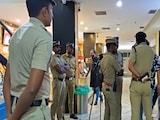Jammu has broken all records post-1910 over the last two days and Udhampur has received 629.4 mm of rainfall over 24 hours -- almost as much as Delhi receives in the whole monsoon. This was what Naresh Kumar -- Senior Scientist in Indian Meteorological Department or IMD -- has told NDTV.
The result has been unmitigated disaster. Large swathes of Jammu has been flooded with most of the rivers flowing above danger mark, sweeping away everything on their path -- bridges, cars, electricity poles and houses. Over the last 48 hours, 36 people have died.
There has been massive rain in Himachal Pradesh and Uttarakhand as well. Earlier this week, the situation in Himachal's Kangra, Una and Chamba districts was extremely worrying. It rained continuously for over 48 hours, causing floods, shutting hundreds of roads to traffic. Before that it was Uttarkashi in Uttaranchal where the situation was similar.
Why The Rain
In an exclusive interview with NDTV, Naresh Kumar said this two-day battering that Jammu received was the result of a confluence of three air masses from three different directions.
One of these, he said, is a Western disturbance from across the border -- which is already causing massive rainfall in Pakistan. The other two air masses are from the Arabian Sea and the Bay of Bengal.
"These three different air masses had their confluence in Jammu and the unexpected rainfall is the result of that," he said.
The Data
Today, data from the IMD showed that Udhampur recorded 629.4 mm of rain in 24 hours till 8.30 am on Wednesday. That much rain on an area of a football field will put it under two feet of water. For a whole district -- it means utter devastation. Delhi receives 640 mm of rain in the whole monsoon - from July to September.
The rain gauge reading for Udhampur is almost double the previous record of 342 mm recorded on July 31, 2019.
In the same period, Jammu city received 296 mm of rain -- surpassing the previous record of 272.6 mm recorded on August 9, 1973.
Jammu district recorded 380 mm of rainfall in 24 hours -- the highest since 1910, when the weather observatory was established.
Devastation In three states
The monsoon fury has destroyed vital infrastructure. Bridges have collapsed, mobile towers and electricity poles have fallen, and many areas are still cut off. There have been communication blackouts across huge swathes and a breakdown in internet services.
Mr Kumar had attributed it to changes in the pattern of monsoon rainfall where some states received short but intense spells of rain.















